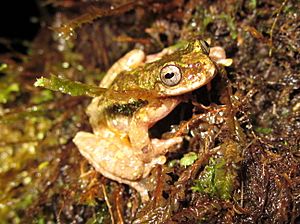Starrett's treefrog facts for kids
Quick facts for kids Starrett's treefrog |
|
|---|---|
 |
|
| Isthmohyla tica in Alajuela, Costa Rica | |
| Conservation status | |
| Scientific classification | |
| Synonyms | |
|
Hyla tica Starrett, 1966 |
Isthmohyla tica, also known as Starrett's treefrog, is a type of frog that belongs to the Hylidae family. You can find this special frog in the mountains of Costa Rica and western Panama. Its name, tica, comes from the word "tico", which is what people from Costa Rica call themselves.
Contents
What Does This Frog Look Like?
Adult male frogs are about 29 to 34 millimeters (1.1 to 1.3 inches) long. Female frogs are a bit bigger, measuring 34 to 42 millimeters (1.3 to 1.7 inches). This measurement is taken from their snout (nose) to their vent (bottom).
Their snout is round. They have a visible eardrum, called a tympanum. There's also a small fold of skin above their eardrum.
Body Features
Their fingers are partly webbed, about one-third of the way. They have flat, round pads at the end of their fingers. Their toes are mostly webbed, about four-fifths of the way. They also have pads on their toes, similar to their fingers.
Colors and Patterns
The frog's back, or dorsum, is a mix of green and brown colors. You might also see some bright green spots on it. The sides of their body are usually brown with yellow patches or spots. Their upper arms are brown or a bit orange. Dark stripes can be seen on the top of their legs. The underside of their body is a dull white color.
Tadpoles
The baby frogs, called tadpoles, have small, somewhat flat bodies. They have a very long tail with low fins. They also have a large mouth that helps them stick to rocks in fast-moving streams. This keeps them from being washed away.
Where Does This Frog Live?
Isthmohyla tica lives in humid rainforests. These forests are found in mountains at elevations from 1,100 to 1,650 meters (about 3,600 to 5,400 feet) above sea level.
Daily Life and Habits
These frogs are nocturnal, meaning they are active at night. Male frogs often call out from plants hanging over the fastest parts of streams. They usually sit about 1 to 3 meters (3 to 10 feet) above the water.
Reproduction and Life Cycle
Female frogs lay their eggs under rocks in these streams. The tadpoles then grow and develop in the water.
How Is This Frog Doing?
Sadly, many groups of Isthmohyla tica have disappeared or their numbers have dropped a lot. Sometimes, a group that was thought to be gone is found again later.
Scientists are not exactly sure why these frogs are disappearing. It might be because of a frog disease called chytridiomycosis. Changes in the weather, known as climate change, might also be a problem. Losing their natural home, or habitat loss, also affects them.
The good news is that this frog has been found in several protected areas. These areas help keep their homes safe.
See also
 In Spanish: Isthmohyla tica para niños
In Spanish: Isthmohyla tica para niños


